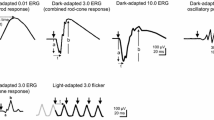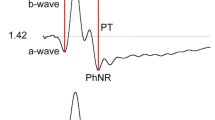Abstract
The internationalStandard for Clinical Electroretinography requires a minimum of 5 standard response types. In a sample of 20 healthy subjects, the normative values according to this standard were established. Since the distribution of amplitude and implicit time does not follow a Gaussian distribution, we have found the median value and the 1st to 99th percentile or the 5th to 95th percentile useful for determination of abnormality, presented here separately for intraindividual and interindividual variation. To improve quality and reliability, we propose that individual laboratories extend the minimum standard and record the standard responses as parts of a stimulus series of increasing intensity. The normal value of the b/a ratio can easily be established from the maximum response to the Standard for Clinical Electrophysiology standard flash, pointing to abnormalities especially in circulatory disturbances and in degenerative diseases of the retina. The b/a ratio is between 1.5 and 1.7. If flicker responses are recorded at the 1st and 10th minutes after the onset of the rod saturating adaptation light (25 cd/m2), an increase in amplitude can be observed, which in our sample has a relative value of 1.3. A reduced increase in cone response amplitudes during light adaptation might point to abnormality within the rod/cone interaction. Responses from the cone system can be further differentiated by the use of chromatic stimuli. With appropriate filters, short-wavelength cone-sensitive and long-wavelength cone-sensitive responses can be differentiated also in clinical daily practice, which might be helpful for further differentiation of cone disorders. Regular measurements of intraindividual variability can help to improve the quality of electroretinogram recordings. Medians and ranges between the 1st and 99th and the 5th and the 95th percentiles were determined for all recordings for interindividual, as well as for intraindividual variations.
Similar content being viewed by others
References
Marmor MF, Arden GB, Nilsson SEG, Zrenner, E. Standard for clinical electroretinography. Arch Ophthalmol 1989; 107: 816–9. Reprinted with permission in Doc Ophthalmol 1989; 73(4): 303–11.
Dawson WW, Trick GL, Litzkow C. An improved electrode for electroretinography. Invest Ophthalmol Vis Sci 1979; 18: 988–91.
Dawson WW, Trick GL, Maida TM. Evaluation of the DTL-corneal electrode. Doc Ophthalmol Proc Ser 1982; 31: 81–8.
Hennessy MP, Vaegan. A comparison of ERG b-waves amplitude-intensity functions from gold-foil, DTL and Burian-Allen electrodes. Invest Ophthalmol 1992; 33: 735. Abstract.
Jacobi PhC, Miliczek K-D, Zrenner E. Klinische Elektroretinographie. Standardprotokoll und Normwerte. Klin Monatsbl Augenheilkd 1993; 202: 27–42.
Gouras P, MacKay CJ, Ivert L. Computer-assisted spectral electroretinography in vitrectomy patients. Ophthalmology 1985; 92: 83.
MacKay CJ, Gouras P. Light-adaptation augments the amplitude of the human cone ERG. Invest Ophthalmol Vis Sci 1985; 26: 323.
Naka KI, Rushton, WAH. S-potentials from colour units in the retina of fish (Cyprinidae). J Physiol 1966; 185: 536–55.
Birch DG. Clinical electroretinography. Ophthalmol Clin North Am 1989; 2: 469–97.
Zrenner E. Grundlagen elektrophysiologischer Untersuchungsmethoden in der Augenheilkunde In: Degenerative Erkrankungen des Auges. Lund OE, Waubke TN, Stuttgart: Ferdinand Enke Verlag, 1983.
Massof RW, Wu L, Finkelstein D, Perry C, Starr SJ, Johnson MA. Properties of electroretinographic intensity-response functions in retinitis pigmentosa. Doc Ophthalmol 1984; 57: 279–96.
Miller S, Sandberg MA. Cone ERG light adaptation in patients with retinitis pigmentosa. Invest Ophthalmol Vis Sci 1990; 31: 2014–7.
Birch DG, Fish GE. Rod ERGs in children with hereditary retinal degeneration. J Pediatr Ophthalmol Strabismus 1986; 23: 227–32.
Fulton AB, Rushton WAH. The human rod ERG: Correlation with psychophysical responses in light and dark adaptation. Vision Res 1978; 18: 793.
Arden GB, Carter RM, Ernst WJK. A modified ERG technique and the results obtained in X-linked retinitis pigmentosa Br J Ophthalmol 1983; 67: 419.
Sandberg MA, Miller S, Berson EL. Rod electroretinograms in an elevated cyclic guanosine monophosphate-type human retinal degeneration: Comparison with retinitis pigmentosa. Invest Ophthalmol Vis Sci 1990; 31: 2283–7.
Gouras P. Identification of cone mechanisms in monkey ganglion cells. J Physiol (Lond) 1968; 251: 167.
Zrenner E, Gouras P. Blue-sensitive cones of the cat produce a rodlike electroretinogram. Invest Ophthalmol Vis Sci 1979: 18: 1076–1081.
Zrenner E, Gouras P. The blue sensitive cone system. In: Shimizu K, Oosterhuis JA, eds. Ophthalmology. Proceedings of the XXIII International Congress, Kyoto. Amsterdam: Excerpta Medica, International Congress Series 1979; 450: 379–84.
Zrenner E, Gouras P. Characteristics of the blue sensitive cone mechanism in primate retinal ganglion cells. Vision Res 1982; 21: 1605–9.
Jacobson SG, Marmor MF, Kemo CM, Knighton RW. SWS (blue) cone hypersensitivity in a newly identified retina. Invest Ophthalmol Vis Sci 1990; 31: 827–38.
Breton ME, Quinn GE, Keene SS, Dahmen JC, Brucker AJ. Electroretinogram parameters at presentation as predictors of rubeosis in central retinal vein occlusion patients. Ophthalmology 1989; 96: 1343–52.
Hood DC, Birch DG. The relationship between models of receptor activity and the a-wave of the human ERG. Clin Vision SCI 1990; 5: 293–7.
Author information
Authors and Affiliations
Rights and permissions
About this article
Cite this article
Jacobi, P.C., Miliczek, KD. & Zrenner, E. Experiences with the international standard for clinical electroretinography: Normative values for clinical practice, interindividual and intraindividual variations and possible extensions. Doc Ophthalmol 85, 95–114 (1993). https://doi.org/10.1007/BF01371126
Accepted:
Issue Date:
DOI: https://doi.org/10.1007/BF01371126




